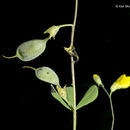Physical Description
(
Inglês
)
fornecido por USDA PLANTS text
Perennial, Herbs, Stems woody below, or from woody crown or caudex, Plants with rhizomes or suckers, Nodules present, Stems erect or ascending, Stems less than 1 m tall, Plants turning black on drying, Stems solid, Stems or young twigs glaucous, Stems or young twigs glabrous or sparsely glabrate, Leaves alternate, Leaves petiolate, Stipules conspicuous, Stipules deciduous, Stipules free, Leaves compound, Leaves palmately 2-3 foliate, Leaf or leaflet margins entire, Leaflets 3, Leaves glabrous or nearly so, Inflorescences racemes, Inflorescence axillary, Inflorescence terminal, Bracts very small, absent or caducous, Flowers zygomorphic, Calyx 5-lobed, Calyx glabrous, Calyx hairy, Petals separate, Corolla papilionaceous, Petals clawed, Petals orange or y ellow, Banner petal ovoid or obovate, Banner petal suborbicular, broadly rounded, Wing petals narrow, oblanceolate to oblong, Wing petals auriculate, Wing tips obtuse or rounded, Keel petals auriculate, spurred, or gibbous, Keel tips obtuse or rounded, not beaked, Stamens 9-10, Stamens completely free, separate, Filaments glabrous, Style terete, Style persistent in fruit, Fruit a legume, Fruit stipitate, Fruit unilocular, Fruit freely dehiscent, Fruit tardily or weakly dehiscent, Fruit elongate, straight, Fruit oblong or ellipsoidal, Fruit orbicular to subglobose, Fruit or valves persistent on stem, Fruit coriaceous or becoming woody, Fruit exserted from calyx, Fruit inflated or turgid, Fruit beaked, Fruit glabrous or glabrate, Fruit 3-10 seeded, Seeds reniform, Seed surface smooth, Seed surface with resinous dots, Seeds olive, brown, or black.
Baptisia tinctoria
(
Inglês
)
fornecido por wikipedia EN
Baptisia tinctoria (common names include yellow false indigo, wild indigo,[1] wild-indigo[2] and horseflyweed[3]) is a herbaceous perennial plant in the family Fabaceae. It is native to eastern North America.
Distribution and habitat
Baptisia tinctoria is found throughout the eastern United States, west to Minnesota, and south to Florida.[4] As it is rare in some parts of its range, it is protected by some state authorities: in Kentucky it is threatened; in Maine it is considered endangered.[5] It prefers dry meadow and open woodland environments.[6]
Description
The multiple bushy stems of Baptisia tinctoria reach 2 to 3 feet tall. The leaves are silver-green; each is divided into three leaflets about ½ inch long. The flowers are yellow and grow in spikes 1½ to 3 inches long.[7]
The leaves are eaten by some lepidopteran caterpillars, for example the Io moth (Automeris io).
On Martha's Vineyard, the species is a tumbleweed: it grows in a globular form, breaks off at the root in the autumn, and tumbles about.[1]
References
-
^ a b C. E. Bessey (1886). "The tumble-weed of the west". Botanical Gazette. University of Chicago Press. 11 (2): 41. doi:10.1086/325904. S2CID 85134259.
-
^ BSBI List 2007 (xls). Botanical Society of Britain and Ireland. Archived from the original (xls) on 2015-06-26. Retrieved 2014-10-17.
-
^ USDA, NRCS (n.d.). "Baptisia tinctoria". The PLANTS Database (plants.usda.gov). Greensboro, North Carolina: National Plant Data Team. Retrieved 9 January 2016.
-
^ Canby, William. "Notes on Baptisia." Botanical Gazette 4 (1879): 129-132.
-
^ USDA, NRCS. 2007. The PLANTS Database (http://plants.usda.gov, 31 May 2007). National Plant Data Center, Baton Rouge, LA 70874-4490 USA.
-
^ "Baptisia tinctoria". Missouri Botanical Garden. http://www.mobot.org/gardeninghelp/plantfinder/Plant.asp?Code=J500 (accessed May 24, 2007).
-
^ Crockett, James U.; Allen, Oliver (1977). "Wildflower Gardening" (1 ed.). Alexandria, Virginia: Time-Life Books.
{{cite journal}}: Cite journal requires |journal= (help)

- licença
- cc-by-sa-3.0
- direitos autorais
- Wikipedia authors and editors
Baptisia tinctoria: Brief Summary
(
Inglês
)
fornecido por wikipedia EN
Baptisia tinctoria (common names include yellow false indigo, wild indigo, wild-indigo and horseflyweed) is a herbaceous perennial plant in the family Fabaceae. It is native to eastern North America.
- licença
- cc-by-sa-3.0
- direitos autorais
- Wikipedia authors and editors

